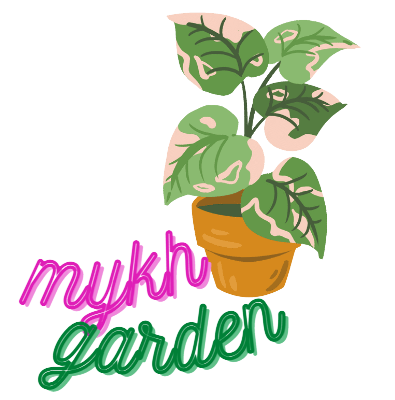Welcome to the captivating world of houseplants, where beauty and life intertwine within our indoor spaces. While the dream of them living forever is alluring, can houseplants live forever? like all living beings, houseplants have a finite lifespan.
Some thrive for decades with care, while others grace us with fleeting moments. Through this journey, we’ll explore their diverse lifespans, the art of proper care, and the enduring legacy they leave behind.
Understanding the varied lifespans of different plant species will deepen our appreciation for the time we have with them, like savoring the fleeting beauty of a blooming flower.
Our role as caretakers involves propagating new life and preserving the essence of their existence.
Together, let us cultivate a sanctuary of growth, learning, and love, celebrating the eternal magic of houseplants in the tapestry of our daily lives.
So, let’s bask in the joy they bring during their time with us and embrace the transient nature of our leafy companions. In nurturing these botanical wonders, we find solace in the ephemerality of life.

Can Houseplants Live Forever?
No, houseplants, like all living organisms, cannot live forever. While some houseplants can live for many years with proper care, they do have a natural lifespan. The length of their life depends on the specific plant species and its growing conditions.
Houseplants can be long-lived, and some have been known to survive for several decades. However, eventually, they will reach the end of their life cycle.
Factors such as genetics, environmental conditions, care, and disease play crucial roles in determining the lifespan of a houseplant.
With proper care, you can extend the life of your houseplants and keep them healthy for as long as possible. Regular watering, appropriate sunlight exposure, proper fertilization, and attention to any signs of pests or diseases are essential to their longevity.
Additionally, repotting when necessary and pruning to promote healthy growth can also contribute to a longer life for your houseplants.
Ultimately, though, every living thing has a finite lifespan, and houseplants are no exception. When a houseplant reaches the end of its natural life cycle, it will start to decline, and despite your best efforts, it may eventually die.
However, many houseplants can produce offspring through propagation methods like taking cuttings or dividing, so parts of the plant can live on in new generations.
5 Longest Living Houseplants
Regarding longevity and resilience, certain houseplants stand as Nature’s Timeless Guardians, captivating our hearts and living by our side for many years.
These enduring botanical companions not only add elegance to our living spaces but also serve as a testament to the wonders of the natural world.
Let’s explore some of these remarkable houseplants that thrive for several years, revealing their secrets to longevity and the ease of care they offer to plant enthusiasts.
1.Snake Plant (Sansevieria trifasciata):
Known for its striking, upright leaves with distinct patterns, the Snake Plant is a hardy trooper that can endure even the most neglectful care.
Nicknamed the “mother-in-law’s tongue,” it can survive in low light conditions and infrequent watering, making it an excellent choice for busy or novice plant owners.
With proper care, the Snake Plant can live for decades, growing into a majestic and air-purifying green giant.
2. ZZ Plant (Zamioculcas zamiifolia):
The ZZ Plant is a true survivor, thriving in low light and tolerating periods of drought. Its glossy, dark green leaves add a touch of elegance to any room.
This plant is not only long-lived but also remarkably low-maintenance, making it an ideal companion for those seeking a resilient and forgiving green friend.
3. Peace Lily (Spathiphyllum):
Don’t be fooled by its delicate appearance; the Peace Lily is a robust houseplant that can live for many years with proper care.
It’s well-loved for its elegant white flowers and its ability to purify indoor air. With bright, indirect light and consistent watering, the Peace Lily will continue to flourish and bloom, spreading tranquility throughout your home.
4. Pothos (Epipremnum aureum):
The Pothos, also known as Devil’s Ivy, is a versatile and long-living houseplant that can thrive in various lighting conditions.
Its heart-shaped leaves come in various shades, adding a touch of beauty to any corner. With occasional watering and moderate light, the Pothos can trail and climb gracefully for years, making it a popular choice for hanging baskets and shelves.
5. Spider Plant (Chlorophytum comosum):
The Spider Plant is a classic favorite for its striking arching foliage and its ability to produce baby plantlets or “spiderettes.” These plantlets can be potted separately, allowing the legacy of the Spider Plant to continue for generations.
With bright, indirect light and regular watering, this resilient houseplant will thrive and bring a touch of charm to your indoor garden.
These long-lived houseplants not only beautify our living spaces but also remind us of the enduring magic of nature. With their ease of care and adaptability, they make wonderful companions for both experienced plant enthusiasts and beginners alike.
So, whether you’re a seasoned green thumb or embarking on your first plant journey, consider welcoming one of these Nature’s Timeless Guardians into your home, and witness the marvel of their longevity as they stand as green sentinels of time.
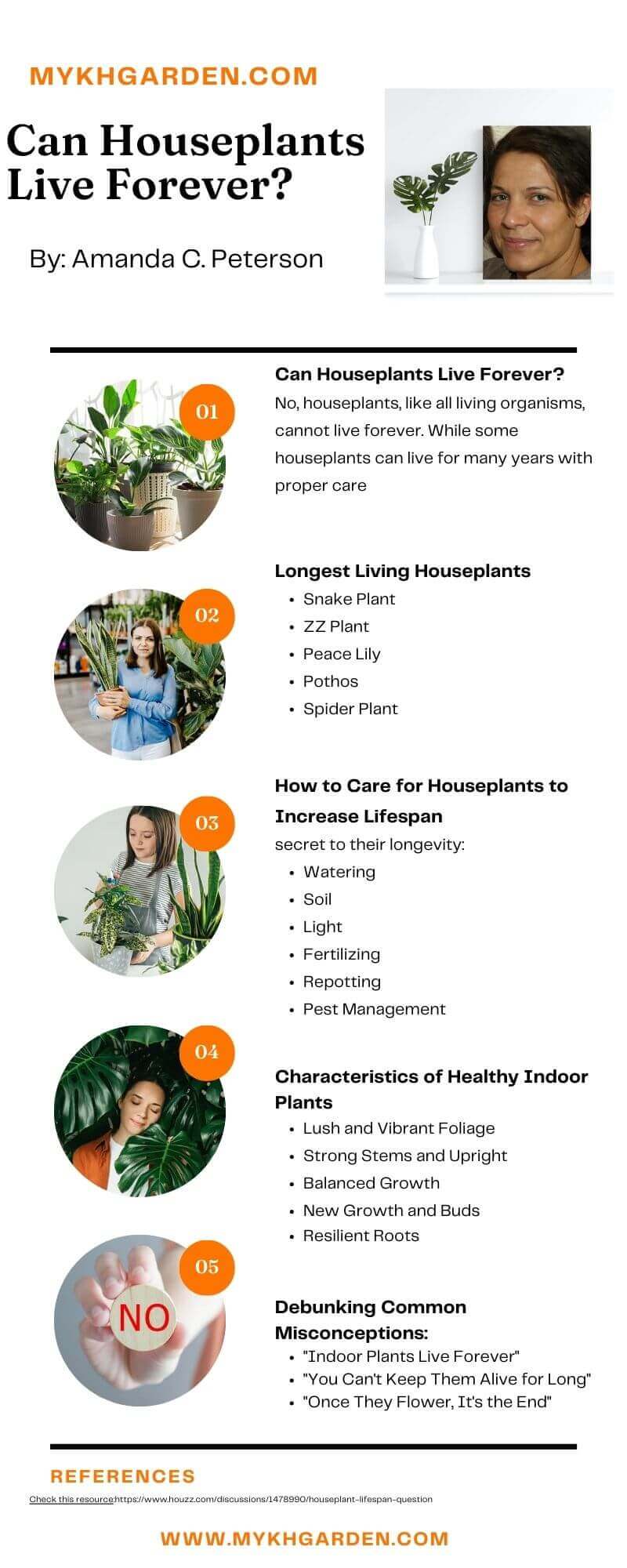
How to Care for Houseplants to Increase Lifespan
Caring for houseplants is an art that, when mastered, can extend the lifespan of our leafy companions and ensure their vitality for years to come.
To unlock the secret to their longevity, let’s explore essential care practices for each aspect of their well-being:
1. Watering:
Watering is a delicate balance, and understanding the needs of each plant is crucial. Overwatering can suffocate the roots and lead to rot, while underwatering can cause wilting and stress.
The frequency of watering depends on the plant species, pot size, and environmental conditions. Always check the soil’s moisture level before watering, and avoid leaving standing water in the saucer.
2. Soil:
Choosing the right type of soil is vital for the health of houseplants. Use a well-draining potting mix to prevent waterlogging, as excess moisture can lead to root problems.
Additionally, consider adding nutrients to the soil or using slow-release fertilizers to ensure a steady supply of essential minerals.
3. Light:
Different houseplants have varying light requirements. Some thrive in bright, indirect light, while others prefer shade or low-light conditions.
Observe your plants closely to identify their specific light needs and place them accordingly. Rotate them occasionally to ensure even growth and prevent light stress on one side.
4. Fertilization:
Fertilizing houseplants provides them with essential nutrients that may be lacking in the soil.
Use a balanced liquid fertilizer or a slow-release granular fertilizer, following the recommended dosage for each plant type.
Avoid over-fertilizing, as excessive nutrients can harm the plant.
5. Repotting:
As houseplants grow, they may outgrow their current pots, leading to root congestion and nutrient depletion.
Look for signs like roots protruding from drainage holes or stunted growth.
When repotting, choose a slightly larger pot with good drainage, and gently loosen the root ball before transplanting.
6. Pest Management:
Keep a watchful eye for common pests like aphids, spider mites, and mealybugs, which can damage the health of your plants.
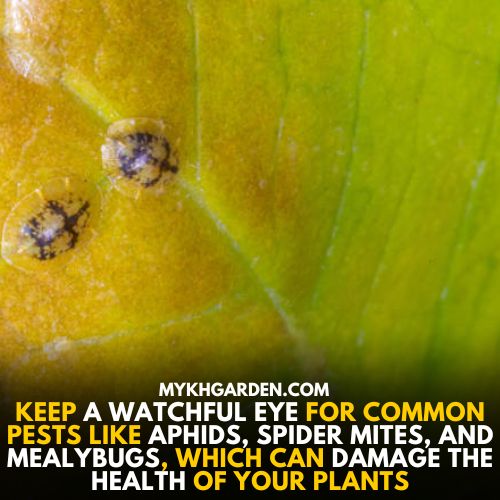
If you notice any signs of infestation, take immediate action. Use natural remedies or environmentally friendly pesticides to control pests without harming the plant or the environment.
By mastering these essential care practices, you become a skilled caretaker, nurturing the well-being of your houseplants and ensuring their longevity.
Avoiding Misinformation About Plant Care to Increase Lifespan
In today’s digital age, a vast garden of information awaits us at the click of a button. However, amidst the abundance of knowledge lies the peril of misinformation, including advice about plant care.
As we tend to our beloved houseplants, it becomes essential to navigate this digital jungle wisely and discern reliable sources from unreliable ones.
Let’s explore how to shield ourselves and our green companions from the pitfalls of misinformation and embrace the importance of evidence-based advice for nurturing healthy, thriving plants.
1. The Prevalence of Misinformation:
The internet is a fertile ground for all sorts of tips and tricks on plant care, but not all information is accurate or suitable for every plant species.
Misconceptions and outdated practices often find their way into forums, social media, and unverified websites, leading us astray from the path of proper care.
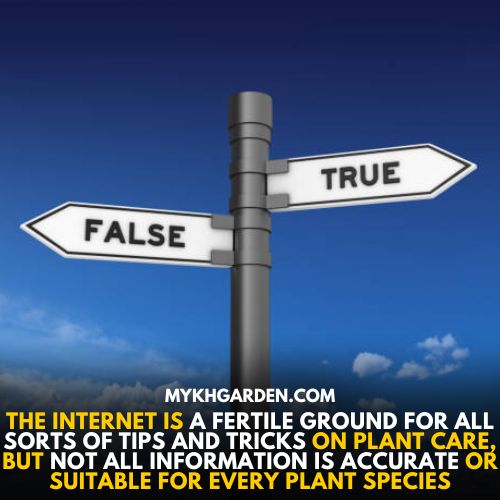
2. Distinguishing Reliable Sources:
When seeking information about plant care, it’s essential to rely on credible sources. Look for websites, articles, and publications backed by renowned botanical experts, horticulturists, and reputable institutions.
Government agriculture departments, university extension programs, and botanical gardens are reliable sources for evidence-based advice.
3. Cross-Reference Information:
When you encounter new plant care tips, cross-referencing them with multiple sources can help confirm their validity. If you find consistent advice from trusted sources, it is more likely to be reliable.
4. Science-Based Recommendations:
Embrace evidence-based advice that is grounded in scientific research and experimentation. Studies on plant physiology, horticulture, and botany provide valuable insights into proper care techniques and are more likely to yield successful results.
5. Be Wary of “Miracle” Solutions:
Be cautious of advice that promises miraculous results or quick fixes. Plants, like any living organism, require time and consistent care to thrive. Avoid remedies that lack scientific backing or seem too good to be true.
6. Observe Your Plants:
Every plant is unique, and factors like environment, climate, and individual health influence their care needs. Observing your plants closely and responding to their specific requirements will guide you in making informed decisions.
7. Seek Guidance from Experts:
If you encounter plant care challenges or uncertainties, don’t hesitate to seek guidance from experienced gardeners, plant nurseries, or local horticultural societies. Their practical knowledge can be invaluable in nurturing your green companions.
By honing our skills of discernment and relying on evidence-based advice, we cultivate a garden of knowledge that protects our houseplants from misinformation’s weeds.
Let us embrace the wisdom of those who have cultivated greenery for generations and harmonize our digital explorations with tried-and-true practices.
In this way, we nourish a bond with our plants that thrives on authentic care, leading to flourishing and resilient indoor gardens filled with the wonder of nature’s beauty.
Saving Plants from Stress to Increase Lifespan
Indoor plants, like us, experience stress as they navigate their green journey within our homes. Understanding and alleviating the factors that burden our leafy companions is essential in promoting their resilience and well-being.
Let’s explore the common stressors that affect indoor plants and the techniques we can employ to nurture tranquility in our little indoor garden oasis.
1. Common Stress Factors for Indoor Plants:
- Inadequate Light: Insufficient or excessive light can cause stress in plants. Some species may struggle in low-light conditions, while others may suffer from scorching under intense sunlight. Understanding the light requirements of each plant and placing them in suitable locations is key to reducing light-related stress.
- Improper Watering: Overwatering or underwatering are common stress factors. Overwatering can lead to root rot and oxygen deprivation, while underwatering can cause dehydration and wilting.
- Providing the right amount of water based on the plant’s needs and soil conditions is vital for their well-being.
- Temperature Fluctuations: Drastic temperature changes can stress plants, especially if they are exposed to drafts or heating vents. Maintaining stable indoor temperatures and protecting plants from extreme weather conditions can help them adapt and thrive.
- Humidity Levels: Indoor environments can sometimes be too dry for certain plant species, leading to stress and leaf problems. Increasing humidity through methods like misting or humidifiers can create a more favorable environment for moisture-loving plants.
- Nutrient Imbalances: A lack of essential nutrients or improper fertilization can hinder a plant’s growth and vitality. Providing balanced fertilizers and supplementing with micronutrients when necessary can help address nutrient deficiencies and promote healthy growth.
- Pests and Diseases: Insect infestations and diseases can wreak havoc on plants, weakening their defenses and causing stress. Regularly inspecting plants for signs of pests or diseases and promptly addressing issues with natural remedies or targeted treatments can save our plants from stress-induced harm.
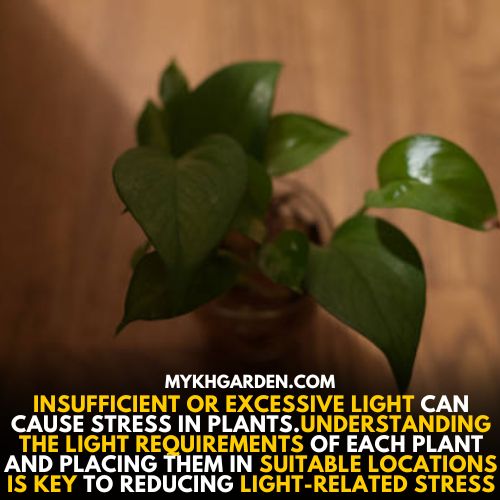
2. Techniques to Reduce Plant Stress and Promote Resilience:
- Consistent Care Routine: Establishing a consistent care routine that includes proper watering, appropriate lighting, and regular fertilization creates a stable and nurturing environment for houseplants.
- Acclimatization: When introducing new plants to your indoor space, gradually acclimate them to their new environment to minimize shock and stress.
- Pruning and Grooming: Regularly pruning dead or damaged leaves and grooming the plants can improve their overall health and reduce stress.
- Proper Plant Selection: Choosing plants that are well-suited to your indoor environment can prevent unnecessary stress and disappointment.
- Observing and Responding: Pay close attention to your plants’ appearance and behavior. Adjust care practices promptly in response to signs of stress to prevent further complications.
- Mindful Repotting: Repot plants when needed, ensuring they have adequate space for root growth. Gently handling the roots during repotting can minimize stress.
By tending to the stressors that affect our indoor plants and adopting nurturing techniques, we create a harmonious indoor garden where tranquility thrives.
As we cultivate resilience and reduce stress, we build a stronger bond with our leafy companions, fostering an environment of serenity and growth within our living spaces.
Let us be the stewards of calm and care, enveloping our indoor garden in the embrace of tranquility and helping our plants flourish, bloom, and inspire us every day.
Identifying Indoor Plant Health to Increase Lifespan
A thriving indoor garden is a sanctuary of green vitality, a living testament to the art of nurturing. Understanding the characteristics of healthy houseplants and decoding the language of their growth patterns are essential skills for every plant enthusiast.
Let’s explore the key traits of healthy indoor plants and uncover the signs that reveal their well-being, allowing us to cultivate a garden of flourishing beauty.
1. Characteristics of Healthy Indoor Plants:
- Lush and Vibrant Foliage: Healthy plants boast lush, vibrant leaves that exude vitality. Their foliage is full, with rich green hues, reflecting their ability to absorb ample sunlight and nutrients.
- Strong Stems and Upright Posture: Robust houseplants have sturdy stems that provide ample support for their leaves and flowers. They stand tall with an upright posture, indicating their strength and health.
- Balanced Growth: Healthy plants exhibit balanced growth, with leaves and stems developing evenly across the plant. This balanced growth prevents lopsided appearances and signifies optimal health.
- New Growth and Buds: Continuous growth and the appearance of new leaves and buds are positive indicators of a plant’s well-being. The emergence of fresh foliage signals that the plant is thriving in its environment.
- Resilient Roots: Healthy roots play a vital role in the well-being of houseplants. Vigorous, white roots that anchor the plant firmly in the soil are signs of a strong and thriving root system.
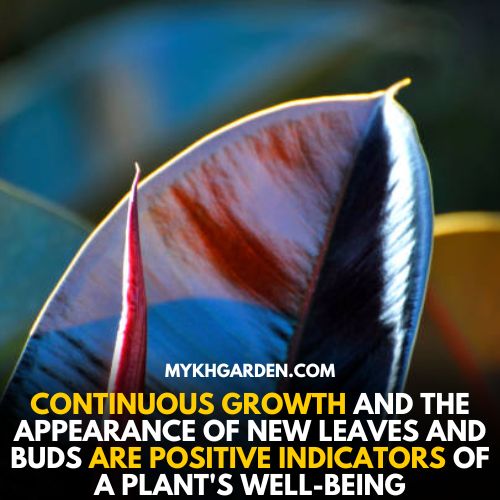
2. Understanding Growth Patterns and Signs of Well-Being:
- Leaf Color and Texture: Pay close attention to the color and texture of the leaves. Bright, consistent green hues indicate good health, while yellowing or browning leaves may suggest stress or nutrient deficiencies.
- Leaf Positioning: Observe how leaves are positioned on the stem. If they are facing upward and following the light source, it shows the plant’s ability to adapt to its environment and absorb maximum sunlight.
- Growth Rate: A steady growth rate is a positive sign of a well-nurtured plant. Excessive growth or sudden growth spurts might indicate that the plant is stretching for light or experiencing an overabundance of nutrients.
- Flowering and Reproduction: The appearance of flowers and plantlets (offshoots) signifies a content and healthy plant. Flowering is an indicator of a plant’s reproductive well-being and its ability to thrive in its current conditions.
- Pests and Diseases: Vigilantly check for any signs of pests or diseases. Early detection and prompt action can prevent the spread of problems and maintain the plant’s overall health.
By understanding the characteristics of healthy indoor plants and interpreting their growth patterns, we become fluent in the language of nature’s green signals.
So, let us embrace the art of reading the language of leaves and stems, forging a deep connection with our plants as they reveal their secrets of thriving health and beauty.
Signs of a Sick Indoor Plant
Even the healthiest indoor garden may face challenges as plants encounter illnesses and ailments. As vigilant caretakers, recognizing the signs of a sick houseplant is essential to providing timely care and fostering a garden of recovery.
Let’s explore the common symptoms of plant illnesses and the steps to effectively diagnose and treat sick indoor plants, nurturing them back to flourishing health.
1. Common Symptoms of Plant Illnesses:
- Wilting or Drooping Leaves: When a plant’s leaves appear limp, wilted, or droopy, it is often a sign of dehydration or root problems. Overwatering, underwatering, or root rot can cause this symptom.
- Yellowing Leaves: Yellowing leaves can indicate various issues, such as nutrient deficiencies, overwatering, pests, or diseases. Pay attention to the pattern of yellowing (e.g., yellowing along the edges, between veins) as it can help pinpoint the cause.
- Browning or Crispy Leaves: Brown or crispy leaves may result from insufficient humidity, underwatering, or exposure to extreme temperatures.
- Leaf Spots: Circular or irregular spots on leaves can indicate fungal or bacterial infections, often caused by excessive moisture on the foliage.
- Stunted Growth: Slow or stunted growth may be a result of poor soil quality, inadequate nutrients, or an unsuitable environment.
- Abnormal Discoloration: Unusual discoloration, such as white patches or blackened areas, may signal pests or diseases affecting the plant.
2. Steps to Diagnose and Treat Sick Houseplants Effectively:
- Inspect the Plant: Carefully examine the plant, both its leaves, and roots, for any visible signs of pests, diseases, or irregularities.
- Identify the Cause: Observe the plant’s symptoms and cross-reference them with common plant ailments. Consider factors like watering routines, light exposure, and environmental conditions to identify potential causes.
- Adjust Watering and Drainage: If overwatering or underwatering is suspected, adjust the watering schedule accordingly and ensure proper drainage to prevent waterlogged soil.
- Isolate the Plant: If you suspect a contagious disease, isolate the affected plant from others to prevent the spread of the issue.
- Natural Remedies: For mild pest infestations or fungal problems, consider using natural remedies like neem oil or soapy water. These are gentle on the plant and environment.
- Pruning and Cleaning: Remove affected leaves and debris to reduce the chances of further spread. Sterilize pruning tools between uses to prevent transmitting diseases.
- Seek Professional Advice: If the problem persists or becomes severe, seek guidance from a local nursery or plant expert who can offer specific recommendations for your plant’s ailment.
By promptly diagnosing and treating sick indoor plants, we become skilled healers, fostering an environment of recovery and growth within our indoor gardens.
As attentive caretakers, we embrace the journey of nurturing, witnessing the resilience of our green companions as they rebound from ailments, and thrive once more.
So, let us cultivate a sanctuary of care and compassion, tending to our plants with unwavering dedication, and celebrating the beauty of restoration in our flourishing indoor garden.
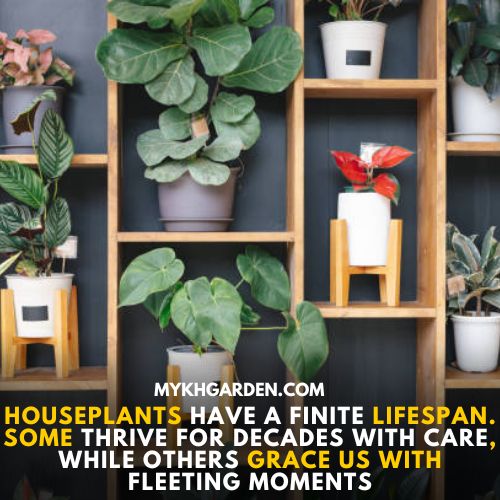
What is the maximum lifespan of Indoor Plants?
In the world of indoor gardening, tales of immortal houseplants and everlasting greens often circulate. However, the true life expectancy of indoor plants is often obscured by myths and misconceptions.
It’s time to separate fact from fiction and shed light on accurate information about the longevity of our botanical companions.
Let’s debunk common misconceptions and provide reliable insights into how long indoor plants can truly thrive.
1. Debunking Common Misconceptions:
- “Indoor Plants Live Forever”: While houseplants can bring enduring joy, the notion of them living forever is indeed charming fiction. All living beings, including plants, have a finite lifespan. Some indoor plants can live for many years, but eventually, they reach the end of their natural cycle.
- “You Can’t Keep Them Alive for Long”: On the other end of the spectrum, some believe that keeping houseplants alive is an insurmountable challenge. With proper care, many indoor plants can thrive for years, and even decades, rewarding us with their beauty and presence.
- “Once They Flower, It’s the End”: Flowering is a natural part of a plant’s life cycle, and it doesn’t necessarily signify its imminent demise. Many flowering houseplants continue to flourish and produce blooms seasonally.
2. Providing Accurate Information:
- Lifespan Varies: The longevity of indoor plants varies significantly depending on the species. Some may only live for a few months to a few years, while others can thrive for several decades with proper care.
- Proper Care Extends Life: The key to extending the life of indoor plants lies in providing the right environment and care. Factors such as appropriate watering, suitable lighting, and proper nutrition play crucial roles in promoting longevity.
- Reproduction and Legacy: Many houseplants have a natural instinct for reproduction, creating new plantlets or offshoots as they grow. Through propagation, we can perpetuate their lineage, even as individual plants complete their life cycle.
- Continuous Learning: As caretakers, we continually learn and adapt our care routines to meet the unique needs of each plant. Each experience contributes to our understanding of their requirements, ensuring their well-being.
By debunking misconceptions and offering accurate information about the life expectancy of indoor plants, we cultivate a deeper appreciation for the journey of nurturing.
Let us cherish the time we have with our green companions, tending to them with love and dedication, and celebrating the beauty they bring into our lives.
In the evergreen world of indoor gardening, it is in their transient existence that the true magic and wonder of houseplants lie.
Popular Indoor Plants and Their Average Lifespan
Indoor gardening opens the door to a diverse array of beloved houseplants, each weaving its unique charm into our living spaces. As we embark on a journey to discover these green companions,
Let’s unveil their average lifespan and explore the care requirements that help them flourish.
1. Snake Plant (Sansevieria trifasciata):
Average Lifespan: Up to 10 years or more.
Care Requirements: Snake plants thrive in low to bright indirect light and can tolerate infrequent watering.
They prefer well-draining soil and are excellent air purifiers, making them perfect for beginners or those with busy lifestyles.
2. Peace Lily (Spathiphyllum):
Average Lifespan: 5 to 7 years.
Care Requirements: Peace lilies thrive in medium to low light and prefer consistently moist soil.
They are sensitive to overwatering, so allow the soil to dry slightly between waterings. With proper care, they reward us with their elegant white blooms.
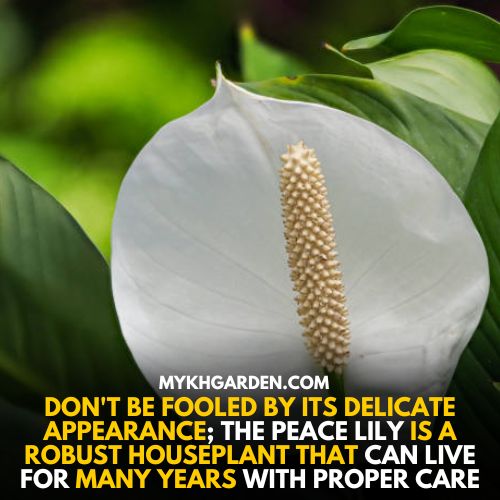
3. Pothos (Epipremnum aureum):
Average Lifespan: 5 to 10 years or more.
Care Requirements: Pothos are low-maintenance and can thrive in various light conditions, from low to bright indirect light.
They prefer well-draining soil and appreciate occasional watering when the top inch of soil dries out.
4. ZZ Plant (Zamioculcas zamiifolia):
Average Lifespan: 5 to 10 years or more.
Care Requirements: ZZ plants are known for their tolerance to low light and drought. They are ideal for spaces with minimal natural light and can go for extended periods without watering.
Avoid overwatering, as they are susceptible to root rot.
5. Rubber Plant (Ficus elastica):
Average Lifespan: 10 years or more.
Care Requirements: Rubber plants prefer bright, indirect light and well-draining soil.
They require consistent watering during the growing season and benefit from occasional misting to maintain humidity.
6. Spider Plant (Chlorophytum comosum):
Average Lifespan: 2 to 5 years or more.
Care Requirements: Spider plants are adaptable and can thrive in various light conditions, from bright indirect light to low light.
They prefer consistently moist soil and produce baby plantlets, allowing them to live on through propagation.
7. Boston Fern (Nephrolepis exaltata):
Average Lifespan: 2 to 5 years or more.
Care Requirements: Boston ferns thrive in high humidity and bright, indirect light. They require consistently moist soil and benefit from occasional misting to maintain humidity levels.
8. African Violet (Saintpaulia):
Average Lifespan: 2 to 5 years or more.
Care Requirements: African violets prefer bright, indirect light and consistently moist soil.
Water them from the bottom to avoid wetting the leaves, as they are susceptible to fungal issues.
These popular indoor plants grace our living spaces with their beauty, and with proper care, they can thrive for several years, becoming cherished guardians of our indoor gardens.
As we embrace the joy of nurturing, let us provide them with the love and care they deserve, ensuring their longevity and the continued splendor they bring into our homes.
Conclusion
In conclusion, now you know if, can houseplants live forever. In the captivating realm of indoor gardening, we’ve unraveled the secrets to extending the life of our beloved houseplants.
Through understanding the actual life expectancy of these green companions and debunking myths, we’ve learned that with proper care and dedication, they can thrive for years, becoming enduring symbols of beauty and vitality in our indoor spaces.
Each plant’s unique needs and growth patterns teach us the art of attentive care, guiding us to create an environment where they can flourish.
From the elegant longevity of the Snake Plant to the delicate grace of the Peace Lily, we’ve discovered the diverse lifespans of our green guardians, and their stories are etched in our hearts.
Now armed with the knowledge of care requirements and signs of well-being, we stand as enlightened caretakers, equipped to foster healthier and longer-lasting indoor plants.
So, dear readers, let us embark on this evergreen adventure with renewed enthusiasm. May the knowledge gained here guide you to create a sanctuary of growth, beauty, and tranquility within your indoor garden.
FAQs
Can houseplants die of old age?
Yes, like all living beings, houseplants have a finite lifespan and can eventually die of old age. However, with proper care, some houseplants can live for many years, extending their lifespan.
How long can houseplants live without water?
The time a houseplant can survive without water varies depending on the plant species, its size, and environmental conditions. Generally, most houseplants can last for a few days to a couple of weeks without water.
How do I know if my plant is dead?
A plant may be considered dead if it shows no signs of new growth, has dried, shriveled, and brittle stems and leaves, or if the roots are decayed and black.
How long do pothos live?
Pothos (Epipremnum aureum) can live for 5 to 10 years or more with proper care. They are long-lived and can thrive in various light conditions, making them popular indoor plants.
Can pothos live forever?
While pothos are long-lived and can thrive for many years, they do not live forever. Like all plants, they have a finite lifespan and will eventually reach the end of their natural cycle.
How long do philodendrons live?
Philodendrons can live for several years to decades with proper care. They are hardy and adaptable plants, making them enduring additions to indoor gardens.
How long do snake plants live?
Snake plants (Sansevieria) can live for up to 10 years or more with proper care. They are hardy and low-maintenance, making them excellent long-lasting indoor companions.
How many years can a house plant live?
Houseplants can live anywhere from a few months to several decades. Some succulents and cycads can survive for over 50 years, while bonsai trees and certain cycads can live for centuries with proper care.
Maximize their lifespan with appropriate light, water, and temperature conditions, along with regular repotting and pest control.
What is the oldest living houseplant in the world?
The oldest living houseplant in the world is believed to be an Eastern Cape giant cycad (Encephalartos altensteinii) named “Encephalartos woodii.” It was housed at the Durban Botanic Gardens in South Africa.
This specific plant is male and is believed to be around 150 to 300 years old, though there are some conflicting estimates on its exact age.
References:
Long-lived houseplants can become heirlooms
Many species of cactus can live a hundred or more years,
